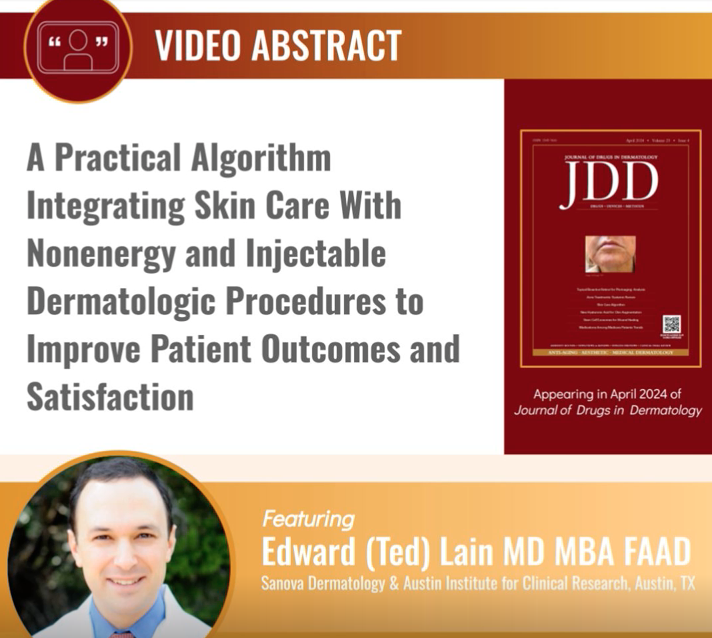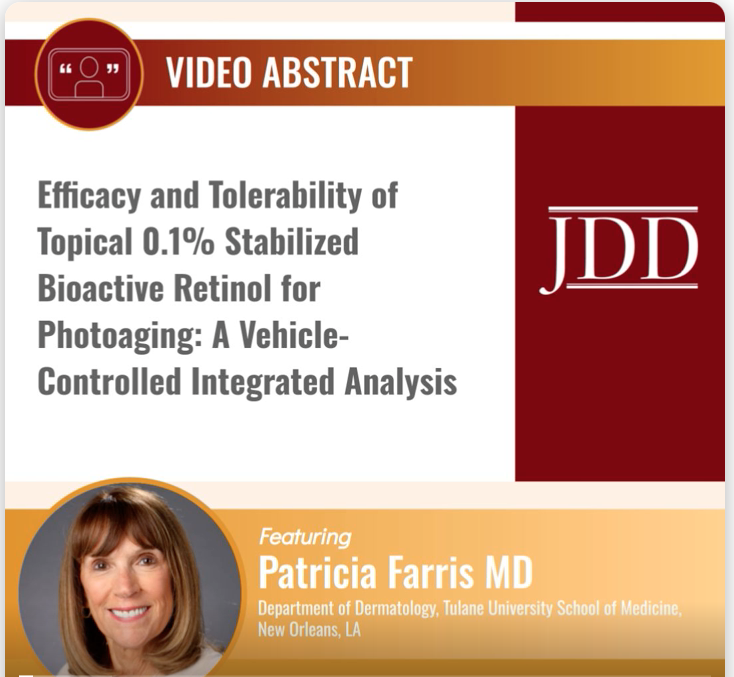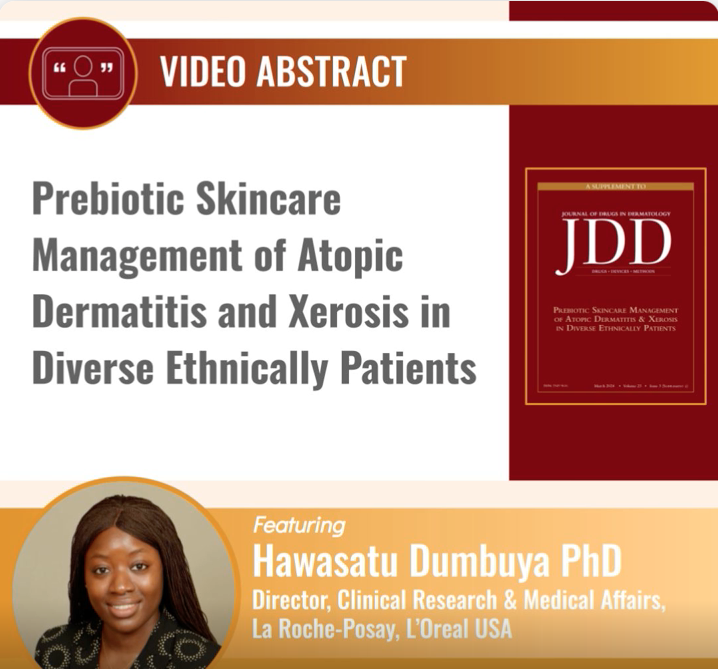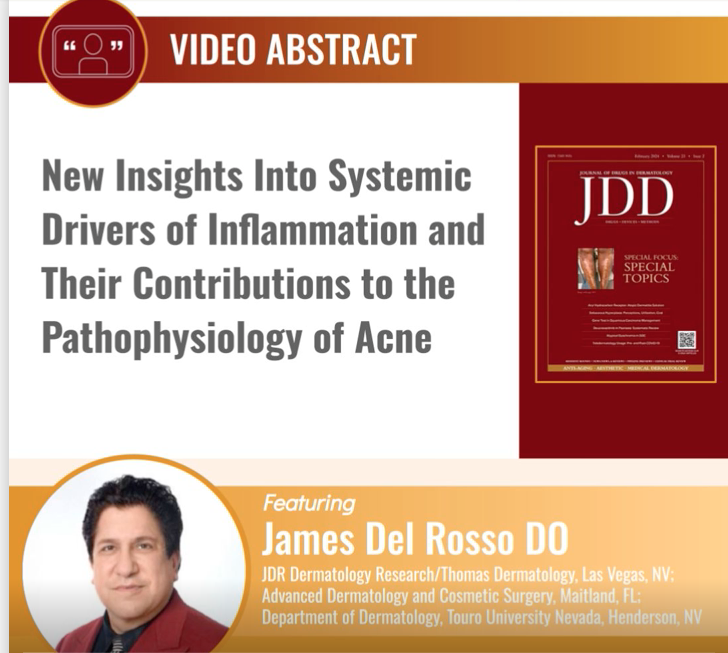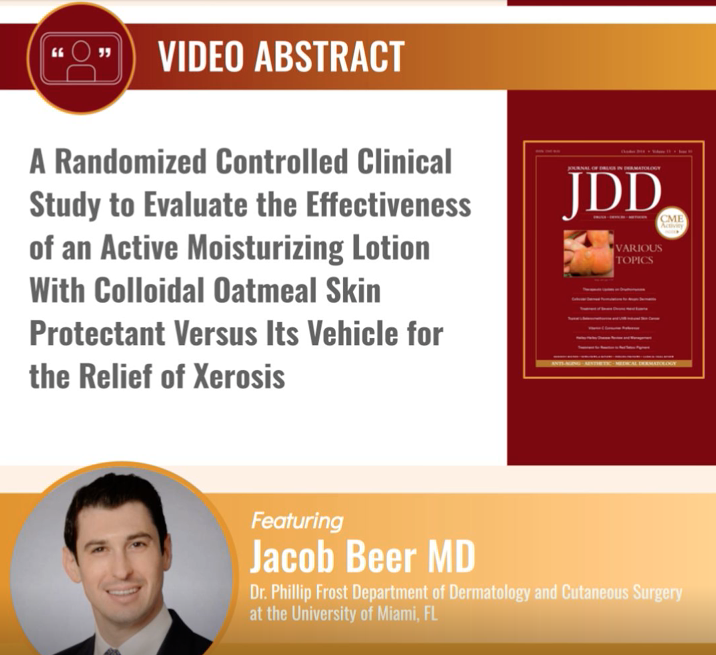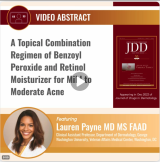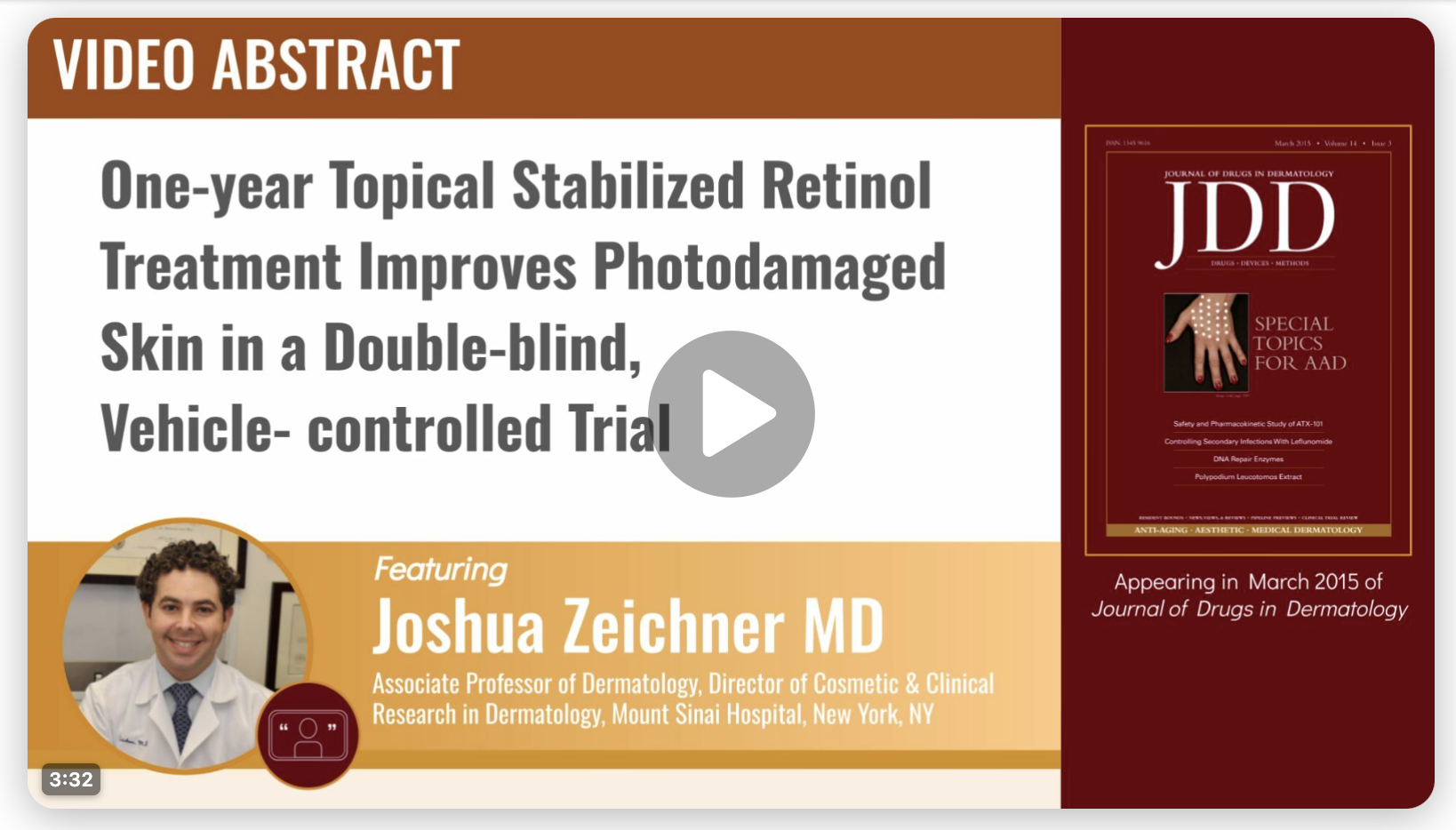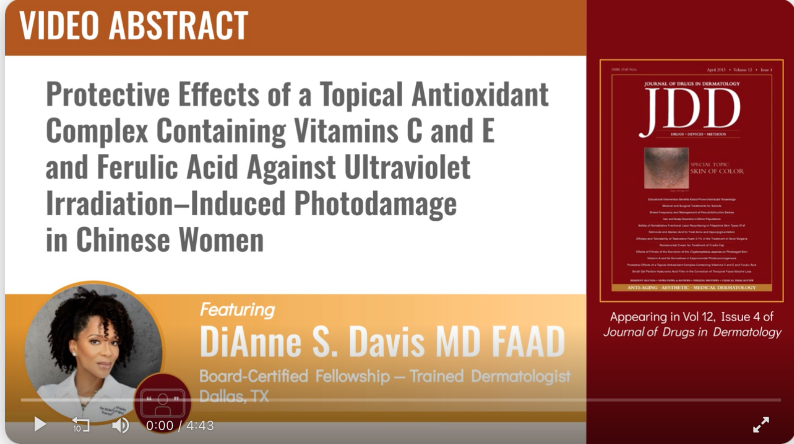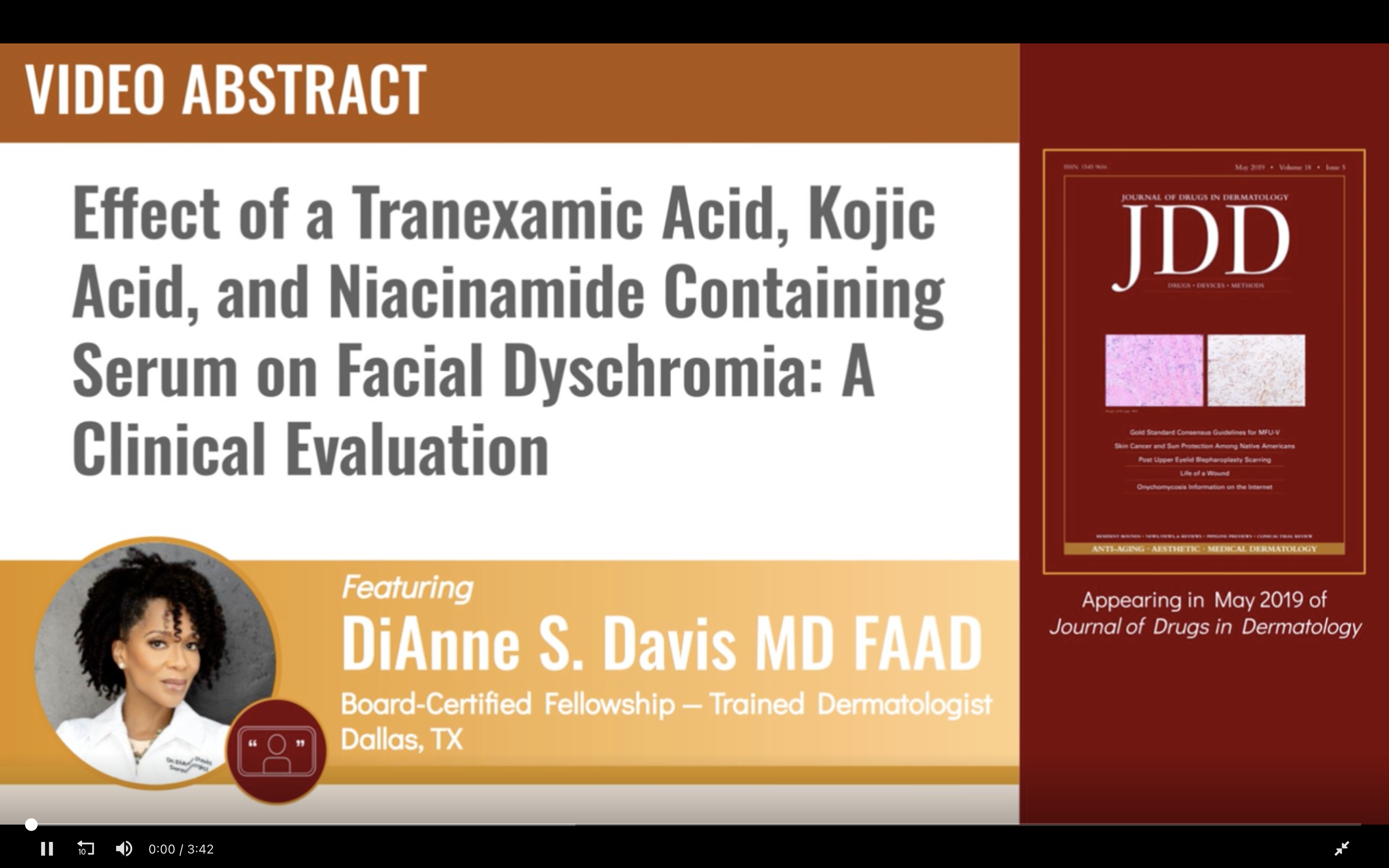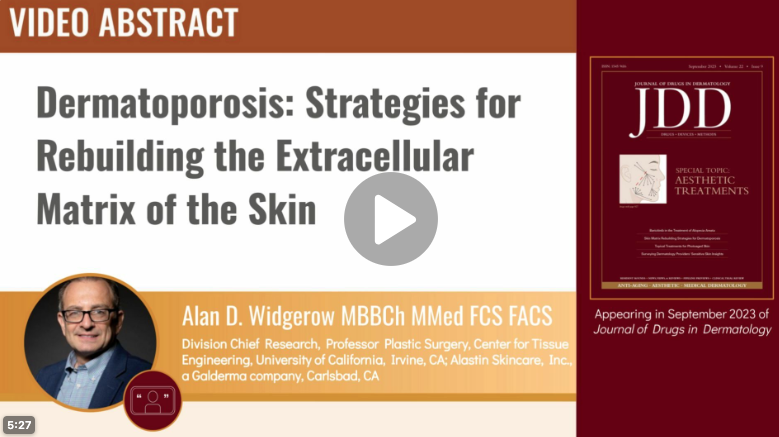Introducing an Exciting NEW Opportunity for Our Authors to Connect with Our Readership through a Cutting-Edge Media Channel! Email us at editorial@jddonline.com to get started!
JDD Video Abstracts
Video Abstracts
NEW VIDEO ABSTRACT!
Retrospective Review of Dermal Safety Studies of Organic Sunscreens
Sunscreens can reduce skin cancer and sunburn. Recent studies on dermal penetration have raised concerns about the safety of sunscreens with organic ultraviolet (UV) filters.
NEW VIDEO ABSTRACT!
Perceptions and Recommendations for Sunscreen: A Cross-Sectional Survey of United States Dermatology Healthcare Providers
The dermatology HCPs in this survey strongly support sunscreen use and believe that FDA-approved sunscreens are effective and safe. The social media findings highlight a continued need to improve education on sunscreen use and increase counseling from clinicians on sun protection behaviors.
NEW VIDEO ABSTRACT!
Open-Label Study: Over-the-Counter Oat Flour/Oat Oil/ Oat Extract-containing Lotion With Avenanthramides for Sensitive Skin and Psoriasis
Psoriasis is a common skin condition that affects the physical and emotional well-being of patients. Moisturizers have been shown to significantly improve skin condition and quality of life in this patient population. Skin afflictions such as atopic dermatitis and pruritis share etiological similarities with psoriasis, and oatmeal (Avena sativa)-containing lotion has proven effective in treating the symptoms of those conditions.
VIDEO ABSTRACT
Skin Barrier Benefits of a Natural Moisturizing Factor and Lipids-Based Moisturizer for Clinically Sensitive Skin
A novel topical cream moisturizer was designed to deliver immediate and long-lasting skin barrier improvements and to improve skin tolerability when used as adjunctive/complementary care by patients with atopic dermatitis (AD), rosacea, or cosmetic intolerance syndrome (CIS), reducing symptoms of skin irritation and sensitivity.
VIDEO ABSTRACT
Study of Adjuvant Sensitive-Skin Cleansing and Moisturizing Regimen in Plaque Psoriasis
Epidermal barrier dysfunction is a key feature of plaque psoriasis. Skincare improves epidermal barrier function and is an increasingly recommended part of psoriasis management.
VIDEO ABSTRACT
Placental Allograft Reconstruction of Cutaneous Wounds Following Mohs Surgery: A Propensity Score-Matched Comparative Cost-Effectiveness Analysis
The purpose of this study was to examine the cost-effectiveness of placental allograft as a nonoperative surrogate to autologous tissue-based methods of defect reconstruction on the face, head, and dorsal hand following Mohs micrographic surgery (MMS).
VIDEO ABSTRACT
PDE4 Inhibitors: Bridging Molecular Insights With Clinical Impact
Phosphodiesterase-4 (PDE4) inhibitors are reshaping the treatment landscape for chronic inflammatory skin diseases by offering effective, non-steroidal options for conditions like psoriasis, atopic dermatitis, and seborrheic dermatitis. This perspective translates recent structural biology and biochemical findings into clinically meaningful guidance.
VIDEO ABSTRACT
A Scientific Approach to Defining, Evaluating, and Treating Pre-Aging With a Cosmetic Regimen Containing a Novel Cosmetic Peptide, Acetyl Dipeptide-31 Amide (AP31)
Pre-aging is a relatively new term used to describe the early, self-perceived signs of skin aging that occur in the 20s and early 30s.1 These early changes include dullness, loss of radiance, uneven skin tone, roughness, loss of firmness, dark circles, and fine lines. This young demographic, comprising both Millennials and Generation Z (Gen Z), is heavily influenced by social media, which provides them with a constant stream of information on cosmetic procedures, skincare trends, and ideals for flawless skin.
VIDEO ABSTRACT
Real-World Clinical Case Series Utilizing Acneceuticals as Monotherapy, Adjunctive, or Maintenance Therapy for Acne Vulgaris
Acne vulgaris is a common, multifactorial inflammatory skin disease for which there are many pharmacologic and procedural interventions. Recent publications have stressed the importance of quality skin care containing non-prescription actives (acneceuticals) in the treatment of this chronic disorder.
VIDEO ABSTRACT
Rituximab in the Treatment of Epidermolysis Bullosa Acquisita: A Systematic Review of the Literature
Epidermolysis bullosa acquisita (EBA) is a rare autoimmune disorder characterized by blistering of the skin and mucous membranes. Current pathophysiology implicates autoantibodies targeting type VII collagen, which serves as a crucial component of anchoring fibrils that attach the epidermis to the dermis. Management of EBA remains challenging and relies on a combination of anti-inflammatory, immunosuppressive, and immunomodulating agents.
VIDEO ABSTRACT
Racial and Ethnic Representation in Atopic Dermatitis Clinical Trials
Atopic dermatitis (AD) is a chronic inflammatory skin disorder afflicting approximately 31.6 million people in the United States, with a disproportionate impact on racial and ethnic minorities who often experience greater disease severity. This study aims to analyze racial and ethnic representation in recent atopic dermatitis clinical trials.
VIDEO ABSTRACT
Acetyl Dipeptide-31 Amide: A Novel Cosmetic Anti-Inflammatory Peptide That Demonstrates Anti-Aging, Firming, and Lifting Benefits
There is continuous demand for safe, effective cosmetic ingredients to treat the signs of aging skin, including fine lines, wrinkles, brown spots, discoloration, laxity, and sagging. While there are a plethora of cosmeceutical peptides, few combine anti-aging and anti-inflammatory benefits with small size.
VIDEO ABSTRACT
GLP-1 Receptor Agonists for the Dermatologist: Uses and Considerations
The glucagon-like peptide-1 receptor agonists (GLP1RAs) are a widely popularized drug class due to their notable success in promoting weight loss. The GLP1RAs, dulaglutide, exenatide, semaglutide, liraglutide, tirzepatide, and lixisenatide are FDA approved for use in the treatment of obesity and type 2 diabetes mellitus (DM), particularly to reduce cardiovascular risk and improve glycemic control.1,2,3
VIDEO ABSTRACT
New Formulations of Acyclothymidine Dinucleosides Reduce Damaging Effects of Ultraviolet Radiation in an Ex Vivo Skin Model
The greatest risk factor for skin cancer is exposure to ultraviolet (UV) rays of the sun. Among the three types of solar radiation (UVA, UVB, UVC), UVB rays are most commonly associated with skin cancer.
VIDEO ABSTRACT
Assessment of the Vehicle for Roflumilast Cream Compared to a Ceramide-Containing Moisturizing Cream in Mild Eczema
Inflammatory dermatologic conditions suitable for topical treatments benefit from a hydrating vehicle that improves the skin barrier without irritation.
VIDEO ABSTRACT
Structural Insights: What Makes Some IL-23 Biologics More Effective in Psoriasis
IL-23 biologics are designed to bind to specific regions (epitopes) on the p19 or p40 subunits, preventing IL-23 from activating its receptor and triggering the inflammatory cascade responsible for psoriasis.
VIDEO ABSTRACT
Pathophysiologic Targets for Acne Treatment
Acne vulgaris is an extremely common dermatologic condition. Individuals with acne present not only to dermatologists, but also to internists, family medicine physicians, pediatricians, estheticians, and beauty counters alike in search of a treatment. The diagnosis of acne is relatively straightforward, leading many to believe that acne is a simple condition.
VIDEO ABSTRACT
Efficacy and Tolerance of a Polymeric Surfactant Technology-Based Cleanser for Clinically Diagnosed Sensitive Skin
Cleansing is an important hygiene activity, necessary to prevent bacterial, fungal, yeast, and viral infection. However, in the presence of skin disease, cleansing can take on a new challenge: removing the sebum, sweat, externally applied substances, environmental debris, and organisms from the face without damaging the skin barrier.
VIDEO ABSTRACT
Image Analysis of Xerosis and Atopic Dermatitis Following Prebiotic Skincare Regimen in Ethnically Diverse Patients
Variations in the epidemiology, clinical presentation, and disease course in atopic dermatitis (AD) patients with Skin of Color (SOC) compared with white counterparts have been reported. In this study, we evaluated the capability of a new imaging device (SkinCam) in quantifying skin texture changes in diverse patients, presenting with AD or xerosis, after using a prebiotic skincare routine over 10 weeks.
VIDEO ABSTRACT
Patient- and Clinician-Reported Outcomes for Tirbanibulin in Actinic Keratosis in Clinical Practice Across the United States (PROAK)
The Patient-Reported Outcomes in Actinic Keratosis (PROAK) study evaluated patient- and clinician-reported outcomes (PRO; ClinRO) during 24 weeks of follow-up among adult patients with actinic keratosis (AK) on the face or scalp who were administered tirbanibulin 1% ointment in real-world community practices in the United States.
VIDEO ABSTRACT
The National Mentorship Match Algorithm: Mentors Needed
The National Mentorship Match Algorithm uses a novel, automated algorithm (Dr SAV) to pair dermatology residency applicants (mentees) with dermatology mentors based on distinct applicant needs and interests.
VIDEO ABSTRACT
Effectiveness and Safety of a New Hyaluronic Acid Injectable for Augmentation and Correction of Chin Retrusion
A hyaluronic acid (HA) filler intended for non-surgical improvement of chin appearance should ideally be of high strength/firmness (high G’) to allow for deep injections on the bone. HASHA (Restylane Shaype) is a new hyaluronic acid (HA) injectable with high G’ and high HA concentration (25 mg/mL), engineered by the new NASHA-HD (High Definition) technology. HASHA is suitable to be placed periosteally, aiming to mimic the natural shape of the bony chin. This pivotal clinical investigation evaluated effectiveness and safety of HASHA for augmentation and correction of chin retrusion.
VIDEO ABSTRACT
A Practical Algorithm Integrating Skin Care With Nonenergy and Injectable Dermatologic Procedures to Improve Patient Outcomes and Satisfaction
The most rapidly increasing medical aesthetic procedures for facial antiaging comprise nonenergy and injectable treatments. Currently, standards for skin care before, during, and after nonenergy and injectable treatments are lacking. The algorithm on supportive skin care for facial antiaging nonenergy and injectable treatments aims to stimulate healing, reduce downtime, and improve comfort and treatment outcomes.
Efficacy and Tolerability of Topical 0.1% Stabilized Bioactive Retinol for Photoaging: A Vehicle-Controlled Integrated Analysis
Chronic exposure to ultraviolet light photoages skin. Retinol, a precursor molecule to retinoic acid that causes less irritation, is available as a nonprescription, cosmetic retinoid and improves collagen production, skin elasticity, and signs of photoaging. Advances in formulation science have allowed the production of stabilized bioactive retinol formulations. This integrated analysis aims to build on previous studies and further examine the comprehensive efficacy and tolerability of topical 0.1% stabilized bioactive retinol.
Prebiotic Skincare Management of Atopic Dermatitis & Xerosis in Diverse Ethnically Patients
Atopic Dermatitis (AD) is a chronic relapsing inflammatory skin disease associated with a significant patient burden on quality-of-life. Rising evidence demonstrate skin microbiome playing an essential role in AD pathogenesis. A decrease in skin microbial diversity, particularly an overabundance of Staphylococcus aureus colonization, is observed on AD lesional skin, plus is associated with disease severity.
New Insights Into Systemic Drivers of Inflammation and Their Contributions to the Pathophysiology of Acne
Acne vulgaris (AV) is a prominent skin disease commonly affecting teenagers. It often persists into adulthood and is associated with adverse physical and psychosocial impacts.
A Randomized Controlled Clinical Study to Evaluate the Effectiveness of an Active Moisturizing Lotion With Colloidal Oatmeal Skin Protectant Versus Its Vehicle for the Relief of Xerosis
Xerosis is a common skin condition, occurring most often in the winter and in low relative humidity, which results in loss of moisture, cracking, and desquamation. Many emollient creams and lotions are available for use as preventive moisturizers.
A Topical Combination Regimen of Benzoyl Peroxide and Retinol Moisturizer for Mild to Moderate Acne
Topical therapies, in many cases over-the-counter (OTC) formulations, are available for the treatment of acne, including benzoyl peroxide (BPO), salicylic acid, and retinoids. While these agents provide therapeutic efficacy, combination regimens can offer improved outcomes due to their ability to address multiple pathways involved in acne formation, making them better suited to address the multiple factors involved in acne pathogenesis and the breadth of complexion issues associated with the condition.
Revisiting the Anchor Flap for Nasal Defects: How It Fits in the Current Reconstruction Paradigm
The anchor or Peng flap, first described in 1987, has not been comprehensively discussed in the literature since 2008. The anchor flap is worth revisiting as a useful advancement-rotation flap for medium-sized defects of the distal nose.
The Interventions to Minimize Pain During Photodynamic Therapy With 5-Aminolevulinic Acid for the Treatment of Cutaneous Diseases
Photosensitization with 5-aminolevulinic acid (ALA) combined with photodynamic therapy (PDT) is approved in the United States for the treatment of actinic keratosis (AK) and is used off-label for other indications including acne treatment and photo rejuvenation.
One-year Topical Stabilized Retinol Treatment Improves Photodamaged Skin in a Double-blind, Vehicle-controlled Trial
BACKGROUND: Retinol, a precursor of retinoic acid, has great potentials as a topical anti-aging molecule; however, only a handful of clinical investigations have been published to date.
Protective Effects of a Topical Antioxidant Complex Containing Vitamins C and E and Ferulic Acid Against Ultraviolet Irradiation-Induced Photodamage in Chinese Women
It is well-known that continuous exposure to ultraviolet irradiation (UVR) leads to various of biological effects, including cutaneous erythema, edema, sunburn, immunosuppression, photoaging, as well as skin carcinogenesis.
Effect of a Tranexamic Acid, Kojic Acid, and Niacinamide Containing Serum on Facial Dyschromia: A Clinical Evaluation
The etiology of skin dyschromia remains complex and its treatment remains challenging, particularly for melasma. Melasma is a common, persistent disorder of hyperpigmentation affecting a significant portion of the population, particularly women living in areas with intense ultraviolet radiation.
Dermatoporosis: Strategies for Rebuilding the Extracellular Matrix of the Skin
Dermatoporosis as a disease entity is relatively newly described, the title conceived as recently as 2007. The background of chronic skin fragility, bruising, and atrophy appears to start in some patients as early as their mid-forties, but is full blown over the age of 65 years.
Scarring and Dyschromias in Fitzpatrick Skin Type IV-VI: A Review of Dermatologic Treatment Protocols
Managing chronic conditions is an essential aspect of dermatologic care, especially regarding the resolution of inflammatory dermatologic disease and recovery of skin lesions.
Assessing Implicit Bias in Dermatology
Patients with skin of color (SOC), defined as Fitzpatrick skin types IV to VI, and of varying ethnicities are under-represented in dermatology. This includes practitioners, trainees, dermatologic teaching materials, and clinical studies.

